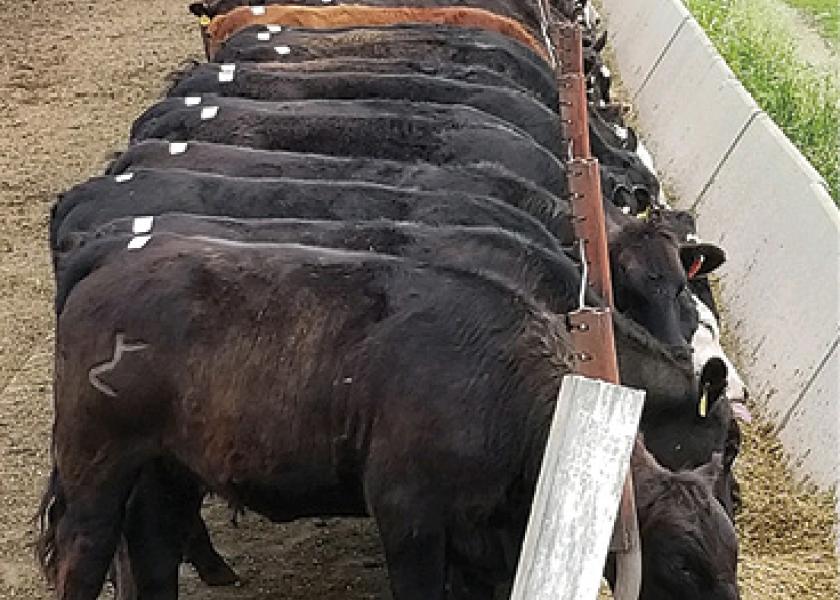Feeding Corn Silage to Cattle Can Add Value

In well-packed, covered corn silage piles, the fermentation process to preserve the silage will be complete after about three weeks. This means that most of this year’s silage crop is ready to feed to cattle. While ranchers may be able to calculate the input costs or the price of selling the corn silage to another producer, it pays to consider the value of feeding corn silage to their own cattle.
“Corn silage has significant value for cow-calf, backgrounding and feedlot operations,” says Zac Carlson, North Dakota State University Extension beef cattle specialist. “Silage is an excellent energy source, providing digestible fiber while improving the palatability and conditioning of the diet with added moisture.”
The tonnage of corn silage harvested and cattle inventory throughout the year often dictate the inclusion level in backgrounding and finishing diets. A survey of farmers and ranchers of the Northern Plains and Midwest reported that the average inclusion of corn silage on a dry matter basis was between 17.1% and 22.2% in backgrounding diets and between 5.4% and 11.4% in finishing diets. However, a summary by the University of Minnesota suggested that corn silage could make up 40% to 60% of diet dry matter and still be economical.
A summary of five experiments by the University of Nebraska evaluated the inclusion of 15% or 45% dry matter corn silage in finishing beef cattle diets. They reported that cattle consumed the same amount of feed dry matter regardless of corn silage inclusion level, but cattle fed 45% corn silage gained 0.2 pound less per day, leading to a 6% poorer feed conversion than cattle fed 15% corn silage.
Corn prices have generally been more expensive in the past few years. Replacing a larger portion of corn in beef cattle diets with corn silage may be an economical solution. However, cattle may need to be fed longer and to heavier weights to reach similar carcass endpoints.
“These decisions should be evaluated as the value of gain versus the cost of gain,” says Karl Hoppe, NDSU Extension livestock systems specialists. “The economics can get complicated and should be evaluated by each individual operation.”
As with all feeds, managing corn silage to minimize shrink is critical.
“Depending on the storage structure you are using, corn silage should be harvested at 65% to 70% moisture for optimum results,” Hoppe says.
Moisture levels that are too low result in less favorable fermentation and poor packing characteristics in the silage, whereas moisture levels that are too high result in silage that has greater effluent losses (loss of nutrients in the water that oozes from the pile). High moisture levels also can result in a “sour” fermentation.
Hoppe also advises packing the silage correctly to ensure oxygen is driven out. Excluding oxygen is a very important aspect of making good-quality silage.
Adequate packing involves a number of factors, including the correct chop length for a particular silage crop and having the appropriately-sized tractor for the amount of silage being placed in the pile. Because wheeled tractors exert more pressure per square inch than crawler or track-type tractors, wheeled tractors are preferred for packing silage.
Poorly managed corn silage that spoils will lose dry matter, requiring the cattle feeder to use additional feed resources to account for lost feed. Making and feeding silage affects shrink, including dry matter at harvest, chop lengths, bunker or drive-over pile filling and packing, inoculation, covering, and feedout.
“Most producers realize the potential benefits of covering silage bunkers and drive-over piles to reduce dry-matter losses and spoilage,” says James Rogers, NDSU Extension forage crops production specialist. “Reasons corn silage bunkers and piles are left uncovered usually include a lack of adequate labor and available time for the task. However, often forgotten is the practice of discarding spoiled silage during feedout. This step is critical when evaluating the feeding value of your silage and the cattle’s performance.”
Only a few studies have evaluated the effects of feeding spoiled silage to cattle. A study by Whitlock and others in 2000 at Kansas State University measured the effect of feeding surface-spoiled (black slime and gray mold material) corn silage to beef cattle. Adding spoiled corn silage to the diet depressed dry-matter intake and decreased crude protein digestibility. Similarly, dry-matter and fiber digestibility decreased with feeding spoiled silage.
“If there is one thing you remember, don’t feed spoiled silage,” Carlson says. “Even if you think the small amount of spoiled silage will be diluted in the diet, it may cost you more than you know."







